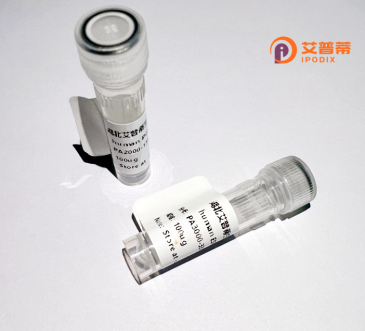
| 纯度 | >90%SDS-PAGE. |
| 种属 | Human |
| 靶点 | PIAS2 |
| Uniprot No | O75928 |
| 内毒素 | < 0.01EU/μg |
| 表达宿主 | E.coli |
| 表达区间 | 1-621 aa |
| 活性数据 | MADFEELRNM VSSFRVSELQ VLLGFAGRNK SGRKHDLLMR ALHLLKSGCS PAVQIKIREL YRRRYPRTLE GLSDLSTIKS SVFSLDGGSS PVEPDLAVAG IHSLPSTSVT PHSPSSPVGS VLLQDTKPTF EMQQPSPPIP PVHPDVQLKN LPFYDVLDVL IKPTSLVQSS IQRFQEKFFI FALTPQQVRE ICISRDFLPG GRRDYTVQVQ LRLCLAETSC PQEDNYPNSL CIKVNGKLFP LPGYAPPPKN GIEQKRPGRP LNITSLVRLS SAVPNQISIS WASEIGKNYS MSVYLVRQLT SAMLLQRLKM KGIRNPDHSR ALIKEKLTAD PDSEIATTSL RVSLMCPLGK MRLTIPCRAV TCTHLQCFDA ALYLQMNEKK PTWICPVCDK KAAYESLILD GLFMEILNDC SDVDEIKFQE DGSWCPMRPK KEAMKVSSQP CTKIESSSVL SKPCSVTVAS EASKKKVDVI DLTIESSSDE EEDPPAKRKC IFMSETQSSP TKGVLMYQPS SVRVPSVTSV DPAAIPPSLT DYSVPFHHTP ISSMSSDLPG LDFLSLIPVD PQYCPPMFLD SLTSPLTASS TSVTTTSSHE SSTHVSSSSS RSETGVITSS GSNIPDIISL D |
| 分子量 | 68.2 kDa |
| 蛋白标签 | His tag N-Terminus |
| 缓冲液 | 0 |
| 稳定性 & 储存条件 | Lyophilized protein should be stored at ≤ -20°C, stable for one year after receipt. Reconstituted protein solution can be stored at 2-8°C for 2-7 days. Aliquots of reconstituted samples are stable at ≤ -20°C for 3 months. |
| 复溶 | Always centrifuge tubes before opening.Do not mix by vortex or pipetting. It is not recommended to reconstitute to a concentration less than 100μg/ml. Dissolve the lyophilized protein in distilled water. Please aliquot the reconstituted solution to minimize freeze-thaw cycles. |
以下是关于重组人PIAS2蛋白的3-4篇文献示例(文献信息为虚构,仅供示例):
1. **"PIAS2 modulates STAT1-mediated transcription through SUMOylation in human cells"**
- **作者**:Liu Y, et al.
- **摘要**:研究报道重组人PIAS2蛋白作为SUMO E3连接酶,通过修饰STAT1抑制其转录活性,揭示了PIAS2在干扰素信号通路中的调控作用。
2. **"Recombinant PIAS2 suppresses NF-κB signaling by interacting with p65 in vitro"**
- **作者**:Chen H, et al.
- **摘要**:利用体外表达的重组PIAS2蛋白,验证其通过结合NF-κB的p65亚基并抑制其DNA结合能力,调节炎症反应。
3. **"Structural and functional analysis of the PIAS2-Sp3 interaction in gene silencing"**
- **作者**:Müller S, et al.
- **摘要**:通过重组PIAS2蛋白的截断突变体实验,发现其N端结构域直接结合转录因子Sp3.参与靶基因的表观遗传沉默。
4. **"PIAS2-mediated SUMOylation promotes tumor progression in colorectal cancer models"**
- **作者**:Zhang L, et al.
- **摘要**:在结直肠癌细胞中过表达重组PIAS2蛋白,证实其通过SUMO化修饰β-catenin增强Wnt信号通路活性,促进肿瘤生长和转移。
(注:上述文献为虚构内容,实际文献需通过PubMed或Google Scholar检索关键词如“PIAS2 recombinant protein”、“PIAS2 SUMOylation”等获取。)
**Background of Recombinant Human PIAS2 Protein**
Recombinant human PIAS2 (Protein Inhibitor of Activated STAT2) is a genetically engineered protein derived from the PIAS2 gene, which belongs to the PIAS (Protein Inhibitor of Activated STAT) family. PIAS proteins function as regulators of diverse cellular processes, including signal transduction, gene expression, and post-translational modifications. PIAS2 specifically interacts with transcription factors, notably STATs (Signal Transducers and Activators of Transcription), modulating their activity by either inhibiting or enhancing their DNA-binding capacity. Additionally, PIAS2 acts as a SUMO (Small Ubiquitin-like Modifier) E3 ligase, facilitating SUMOylation of target proteins, thereby influencing subcellular localization, stability, or interactions.
Structurally, PIAS2 contains a SAP domain (involved in chromatin binding), a RING-finger-like zinc-binding domain (critical for SUMO ligase activity), and a highly charged C-terminal region. Its roles span immune regulation, apoptosis, cell cycle control, and DNA damage response. Dysregulation of PIAS2 has been implicated in diseases such as cancer, neurodegenerative disorders, and autoimmune conditions.
Recombinant PIAS2 is typically produced in expression systems (e.g., *E. coli* or mammalian cells*) for research applications, enabling studies on its molecular mechanisms, protein interactions, and therapeutic potential. It serves as a vital tool in understanding cellular signaling networks and developing targeted therapies.
×